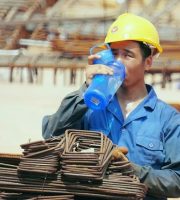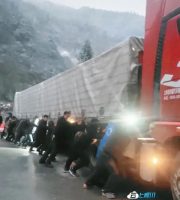Concrete replacement method concrete replacement method is an effective method to deal with seriously damaged concrete.
When pouring and tamping is started again, the interval between the previous pouring is up to 4 hours, and the lower concrete is basically solidified.
6、 Preventive measures for cold joints (1) the pouring must be completed before the initial setting of the lower concrete to prevent construction cold joints.
Cathodic protection, chloride extraction and alkaline recovery are three common and effective methods in chemical protection.
Treatment process: manual roughening and high-pressure water flushing: the roughing water pressure reaches 25-50mpa, the efficiency is high, the gap period exceeds 2 weeks, and the roughing effect is poor.
It imitates the function of biological tissue to automatically secrete some substance to the injured part and make the injured part heal.
6.
During construction, the concrete joint lasts too long and solidifies, resulting in cracks due to different shrinkage at the concrete joint (commonly known as cold joint).
Bionic self-healing method bionic self-healing method is a new crack treatment method.
Some special components (such as liquid core fiber or capsule containing binder) are added to the traditional components of concrete to form an intelligent bionic self-healing neural network system inside the concrete, When cracks appear in concrete, some liquid core fibers secreted can make the cracks heal again.
It can be used for both cracked structures and new structures.
3、 Cold joint is harmful to the cold joint during the pouring of reinforced concrete structure.
cold joint treatment process 1.
Roughening with air sand gun: it is effective for roughening concrete with long age, but it is labor-consuming, time-consuming and material consuming, and the construction interference is large.
Water may rust reinforcement through the cold joint and affect the self waterproofing and service life of the structure.
Due to the failure of the concrete pump, the pouring and tamping is interrupted.
Common replacement materials are: ordinary concrete or cement mortar, polymer or modified polymer concrete or mortar.
Electrochemical protection electrochemical corrosion prevention is to change the environmental state of concrete or reinforced concrete and passivate reinforcement by using the electrochemical action of applied electric field in the medium, so as to achieve the purpose of corrosion prevention.
What is concrete cold joint? Cold joint refers to a weak surface formed in the concrete structure due to the interruption of concrete pouring caused by unexpected factors during concrete pouring, and the interval is longer than the initial setting time of concrete, but less than the final setting time of concrete.
Surface repair method surface repair method is a simple and common repair method.
The main treatment methods are as follows: IV.
After hardening, the cementitious material forms a whole with the concrete, so as to achieve the purpose of plugging and reinforcement.
At the same time, in order to prevent the concrete from cracking under the influence of various effects, measures such as pasting glass fiber cloth on the surface of the crack can be adopted.
(2) Adjust the thermal insulation and curing measures, delay the temperature rise and fall rate, reduce the water consumption of concrete and increase the workability of concrete.
Structural reinforcement method when cracks affect the performance of concrete structure, reinforcement method should be considered to deal with concrete structure.
2.
5、 Difference from construction joint: construction joint refers to a joint between new and old concrete “deliberately” due to construction technology, construction strength, concrete temperature control measures and other reasons, but the construction joint needs to be treated by chiseling, setting tie bars, setting water stops and other measures.
2.
The initial setting time of high-quality concrete is 4 hours.
If conditions permit, add retarder in the concrete to prevent construction cracks.
Grouting and inlay plugging method grouting method is mainly applicable to the repair of concrete cracks that have an impact on the integrity of the structure or have anti-seepage requirements.
Commonly used plastic materials include PVC mastic, plastic ointment, butyl rubber, etc; The common rigid water stop material is polymer cement mortar.
(5) The vibrator shall be inserted into the lower concrete 50-100mm, the moving distance of the immersion vibrator shall not be greater than 1.5 times of its action radius, for fine aggregate concrete mixture, it shall not be greater than 1 time of its action radius, and the spacing of insertion points shall not exceed 400mm…
Source: in case of infringement by the supervisor, please contact to delete 1.
2.
The main methods commonly used in structural reinforcement are as follows: increasing the cross-sectional area of concrete structure, outsourcing section steel at the corners of components, strengthening with prestressed method, pasting steel plate, adding fulcrum reinforcement and shotcrete reinforcement.
The cold joint will bring great hidden danger to the reinforced concrete structure, affect the holding and wrapping force of concrete on reinforcement, affect the integrity of reinforced concrete structure and the protection effect of concrete on reinforcement.
Low pressure water roughening: after the final setting of concrete, roughening with 0.3-0.6mpa water pressure may wash away 2-3cm thick surface concrete.
(3) Reduce the layer thickness of concrete pouring.
Wire brush mechanical bristles: high efficiency, good effect and high cost.
Treatment concept: manually chisel off the emulsion skin on the concrete surface, wash it with clean water, remove the stone mortar joint, and strengthen vibration and maintenance.
It is suitable for long-term corrosion protection of reinforcement and concrete.
5.
It uses pressure equipment to press the cementitious material into the cracks of the concrete.
Caulking method is the most commonly used method in crack sealing.
3.
2.
It is mainly applicable to the treatment of surface cracks and deep cracks that are stable and have no impact on the bearing capacity of the structure.
Due to negligence, no special construction joint treatment measures are taken between the two layers of concrete, resulting in cold joints.
Common cementing materials include cement slurry, epoxy resin, methacrylate, polyurethane and other chemical materials.
Cold joint treatment methods: 1.
The biggest difference between the two is: one is improper construction, the other is construction needs.
For cold joint, first analyze the causes of crack formation, observe the condition of crack (whether it is through), and then deal with it according to the specific situation.
(4) The one-time pouring shall be carried out by the inclined plane layered method without forming cold joints.
The advantage of this method is that the protection method is less affected by environmental factors.
It usually chisels along the crack and fills the groove with plastic or rigid water stop materials to seal the crack.
2、 Causes of cold joint 1.
This method is to remove the damaged concrete first, and then replace it with new concrete or other materials.
The usual treatment measures are to apply cement slurry, Epoxy Mastic on the surface of the crack or paint, asphalt and other anti-corrosion materials on the concrete surface.



